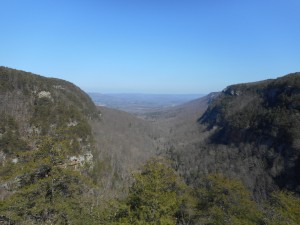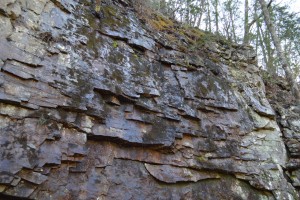As a geological formation, Cloudland Canyon is part of the larger structure of Lookout Mountain and the convergence of the Ridge and Valley landscape and Appalachian plateau found in northwest Georgia near Tennessee. The state park was establish in 1938 and currently has a total of 3,485 acres under protection. Formed by the deep erosion of the sedimentary rock beneath the Bear and Daniels Creeks, Cloudland Canyon is a unique structure and one that is the result of millions of years and countless geological events both large and small throughout history (Cloudland). These rocks are primarily from the Paleozoic era at a time when this portion of the United States was deep underwater, though their ridge-and-valley topography comes from the collision of Africa, South America, and North America to form one continent beginning in the Cambrian period (Chowns).
 One of the most interesting aspects of the formation of Lookout Mountain, and hence Cloudland Canyon, is the role that volcanism played as a major geomorphological influence. This landform began to appear nearly 700,000 years ago and possesses a wide crater at its summit about two kilometers in diameter. Despite the volcanism in this area, however, Cloudland Canyon is still comprised primarily of sedimentary rock (USGS). Why is this? During the Alleghanian orogeny mentioned previously (when Africa, South America, and North America collided to form one continent) the Ridge and Valley landscape became much more prominent and portions of this area, such as the area containing Cloudland Canyon, were forced on top of the upwelling ground while the obsidian formed from the lava of the volcano reaching the surface remained around the summit of Lookout Mountain (Gore).
One of the most interesting aspects of the formation of Lookout Mountain, and hence Cloudland Canyon, is the role that volcanism played as a major geomorphological influence. This landform began to appear nearly 700,000 years ago and possesses a wide crater at its summit about two kilometers in diameter. Despite the volcanism in this area, however, Cloudland Canyon is still comprised primarily of sedimentary rock (USGS). Why is this? During the Alleghanian orogeny mentioned previously (when Africa, South America, and North America collided to form one continent) the Ridge and Valley landscape became much more prominent and portions of this area, such as the area containing Cloudland Canyon, were forced on top of the upwelling ground while the obsidian formed from the lava of the volcano reaching the surface remained around the summit of Lookout Mountain (Gore).
 While Cloudland Canyon at its core is an erosional feature formed by two creeks and soft sediment, its history is much deeper and longer. Volcanism, oceans and underwater deposition, erosion, and millions of years have all combined to form this beautiful wonder of Georgia’s national landscape now protected by the Georgia state government. While the current landform may be thought of as an end or static state, the reality is that the geology of Cloudland Canyon is still evolving and changing and this location is still very much open to geomorphological study.
While Cloudland Canyon at its core is an erosional feature formed by two creeks and soft sediment, its history is much deeper and longer. Volcanism, oceans and underwater deposition, erosion, and millions of years have all combined to form this beautiful wonder of Georgia’s national landscape now protected by the Georgia state government. While the current landform may be thought of as an end or static state, the reality is that the geology of Cloudland Canyon is still evolving and changing and this location is still very much open to geomorphological study.
Authored by Julie Fowler
Citations
Chowns, T. (2006, July 04). Valley and Ridge Geologic Province. Retrieved February 14, 2016, from http://www.georgiaencyclopedia.org/articles/science-medicine/valley-and-ridge-geologic-province
Cloudland Canyon State Park. (2007). Retrieved February 14, 2016, from http://www.gpb.org/sitestobehold/cloudland-canyon-state-park
Gore, P. J. (2006, January 07). Geologic History of Georgia: Overview. Retrieved February 14, 2016, from http://www.georgiaencyclopedia.org/articles/science-medicine/geologic-history-georgia-overview
USGS: Volcano Hazards Program CalVO Long Valley Caldera. (n.d.). Retrieved February 14, 2016, from http://volcanoes.usgs.gov/volcanoes/long_valley/long_valley_sub_page_18.html